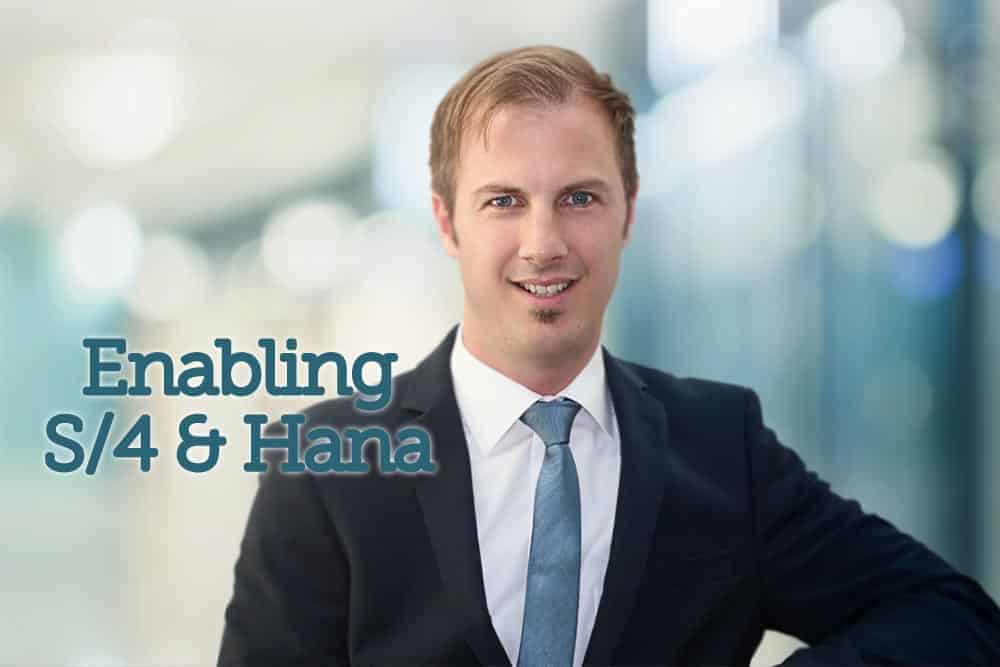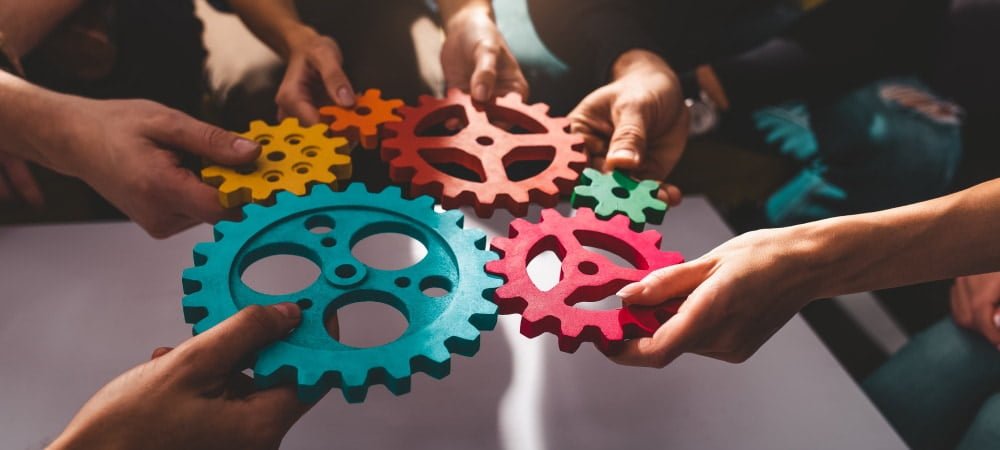Enabling S/4 and Hana


The starting signal for a new ERP era has been given by SAP. The reverberations in the SAP community are ambivalent, because it is a matter of replacing successful R/3 Enterprise, ERP/ECC 6.0 and Business Suite 7 systems - the IT adage still applies: Never change a running system!
But the digital transformation and enabling of IoT, cloud and mobile computing requires new platforms and technologies. SAP came along at just the right time with its in-memory computing platform Hana and the real-time enterprise concept S/4.
Naturally, the SAP community discusses the switch to a new ERP generation with great commitment - but not always voluntarily: The world of business processes is changing. Industries are forming "business eco-systems" and merging. The result, as presented by DSAG e.V. at this year's annual congress in Nuremberg: Different business models meet and result in a 360-degree view of markets. Generated data is increasingly becoming a business model. The prerequisites to meet this change are created by technology. What role will SAP occupy in this scenario? What does its position as a software manufacturer of integrated business processes, business networks and hybrid business platforms mean? What is the significance of other players on the software market?
S/4 kick-off
Frank Scharpenberg, Atos Director in E-3 conversation:
"We have some active S/4 Hana customers in Germany and Europe, or customers who are about to go live" "But the majority of active customers are new customers who have taken the opportunity to jump on the new ERP generation now."
However, the digital transformation affects all existing SAP customers, which Scharpenberg confirms: "S/4 Hana is an important topic for all of our customers. In the midmarket segment, we are working on concrete implementation and rollout scenarios. The larger customers are still somewhat more restrained and are currently more concerned with their general S/4 Hana roadmap and are setting up concrete proofs of concept."
Frank Scharpenberg is optimistic for 2017: "Next year, we expect an exponential increase in the acceptance curve." One thing is clear: New digital processes need stable core systems that can be expanded, modified or supplemented. What do SAP's solutions look like for this? According to the DSAG user association, SAP's existing customers are using the Business Suite, a mature platform for which extensive know-how has been accumulated over the years.
Here, DSAG expects adequate further development of existing solutions that does not favor new products such as S/4 Hana. This goes hand in hand with the quality of the systems delivered. "We need more process quality in the form of error-free delivered solutions, which helps companies with their digitization strategy," explained Marco Lenck, DSAG Chairman of the Board, in Nuremberg. And he adds:
"In the future, software solutions must be easy to operate, otherwise companies will be held back too much in their digitization projects."
Hana, SoH and S/4
In terms of time, first there was Hana, then SAP Business Suite on Hana (SoH), and then S/4. What is the status of SoH? How many productive SAP legacy customers are there here? "The number is significantly higher here, because a technical migration is much easier than touching the processes," says Frank Scharpenberg, describing the SAP community's move to a future with Hana, SoH or S/4.
Frank Scharpenberg, Atos Director in E-3 conversation:
"Many existing customers took advantage of SAP's discount promotions in the early stages and got the appropriate licenses for Hana DB or, last year, S/4 Hana."
But, Scharpenberg tells E-3, with SoH you can talk about tried and tested practice, which puts the Atos director in line with Marco Lenck.
Against this backdrop, the bottom line is that it is essential for SAP customers to be able to drive digitization with different solutions. At a pace that is not determined by the expiration of maintenance. Marco Lenck comments: "Based on the new SAP technologies and with regard to the existing solutions, we expect more functionality and better integration of the solutions. In addition, we lack meaningful roadmaps to be able to plan for the next years." Thus, SoH seems to be an interesting challenge for existing customers because they can keep their business suite with all business processes and get a fast in-memory computing database.
Who and why should you make the move from Business Suite with AnyDB to SoH?
Frank Scharpenberg, Atos Director in E-3 conversation:
"On the one hand, the Hana DB offers a significant acceleration of the business processes in the system in various areas, which has an impact on the productivity of the companies. For example, we have been able to prove for a large customer that, on the basis of SoH, its average process performance has improved by a factor of 2.9 - in some areas even significantly higher.
Furthermore, many companies have already purchased the licenses. Thus, it is interesting for them for cost reasons alone. In addition, the storage requirements are significantly reduced. This means that a concrete business case can be calculated for each individual customer. Last but not least, I consider the path via SoH for larger and more complex installations to be a good intermediate step on the way to S/4."
Bernd Leukert, SAP's Chief Technology Officer, argued a similar case at Sapphire in Orlando, USA, back in 2015:
Bernd Leukert:
"For today's customers, continuous processes and the ability to personalize are a basic requirement. They expect companies to use the latest technologies."
What challenges arise with SoH and what are Atos' services for this database change? "First of all, a business case analysis has to be carried out and then, based on this, the SAP licenses required have to be purchased," says Scharpenberg, defining the basic procedure. If the customer is not an existing SAP customer, he can buy the licenses from Atos. In addition, the necessary hardware must be selected and procured by the customer. Depending on the release status of the customer's existing ERP solution, a software upgrade to ERP/ECC 6.0 and EhP 7 (Enhancement Package) may still have to be performed so that the system can be migrated to SoH at all. After that, the code conversion can take place.
Frank Scharpenberg, on Atos' implementation and added value:
"Here, Atos leverages its Migration Factory in India with appropriately semi-automated tools and performs the database migration to Hana"
Finally, Atos supports the customer in testing the new SoH system as well as the Go Live. "With our Hana-certified Bullion servers, we are able to offer the customer an end-to-end package for their migration to Hana, including hosting and application management if desired," says Frank Scharpenberg, describing the Atos way, and he proudly adds: "Here we can draw on extensive experience with the Hana migration at Siemens and other customers."
Target 2025
How does Atos explain the release change to a potential SoH customer? As an ERP system for the next ten years or as an intermediate step with the ultimate goal of S/4 by 2025?
Frank Scharpenberg:
"In addition to the fast database, S/4 Hana offers other clear advantages such as integrated data storage, the new user interfaces, and the introduction of IoT as a platform for the digital world. In addition, new developments will essentially only take place in the S/4 environment. The timeframe until 2025 may seem long from a maintenance point of view, but I believe that a major wave of adaptation will set in over the next few years due to the content advantages alone."
In this sense, the Atos Director is in complete agreement with the statements made by Bernd Leukert, SAP's Chief Technology Officer.
"We have worked closely with our customers as they evolve in the digital economy to identify where digitized processes can add the most value to them," said Leukert at Sapphire 2016 "The result is a completely redesigned suite that makes S/4 Hana the first digital core for digital business processes. Companies can thereby achieve unique added value using innovative application scenarios in key financial and operational areas such as logistics. In doing so, they benefit from simplified data models and a flexible user interface."
Time-to-Market
DSAG recently announced that even an SAP Business Suite with AnyDB is already a very good system for digital transformation, IoT and Industry 4.0. Is that true?
Frank Scharpenberg:
"In essence, I don't think this statement is wrong. For many customers, SAP is the 'backbone' in their business processes and will remain so in the future. However, these are often historically grown, highly individualized systems. In the age of digital transformation, however, companies also need increased flexibility and speed of adaptation - keyword: time-to-market. Who can say right now exactly what challenges their company will have to overcome in the context of digitization in three years' time, and which competitors will attack their core business with which innovative business models?"
With this statement, Scharpenberg explains the connection between old and new, between the strategies of the SAP community and the visions of SAP. Like Bernd Leukert, the Atos Director sees the added value: "Furthermore, with the increasing volumes of data, for example through IoT and Industry 4.0 use cases, scalability will play a decisive role. That's why I think it's right to see the switch to the new ERP generation as a springboard and to position oneself accordingly here. IT and technology must not become a bottleneck. That's why we shouldn't forget in the whole SoH discussion that a direct leap - Greenfield with S/4 Hana - offers a unique opportunity to cut off old ties and completely reposition ourselves for the digital age."
And what constraints or advantages does this impose on SoH aspirants? What are the findings from implementation practice? "In practice, we were able to confirm the significant performance gains and reduced storage requirements propagated by SAP in many areas," says Scharpenberg in an E-3 interview. "One limitation compared to S/4 Hana is certainly that I accelerate my old processes, but the other process-relevant benefits - such as the elimination of data updates for reporting purposes - are not picked up.
Here, however, you have to see whether all the required logistics functionalities are already fully available and mature. But SAP does a good job of closing the gaps quickly," says Scharpenberg from his professional experience, and he adds: "Of course, with the two-stage approach - first SoH, then S/4 Hana at some point - I initially have higher expenses due to the two projects. But that can make sense from a risk minimization perspective!"
Alternatives
What is the alternative to SoH? Wait until 2020, when S/4 will probably have a similar range of functions? Or start today with the S/4 add-ons Finance and Logistics? "Of course, this depends on the individual starting situation and objectives of each company," defines Scharpenberg.
"If I already have Hana DB licenses, want to take advantage of the speed benefits, and want to gain some experience with the new technology and the necessary adjustments - e.g. code conversion - before switching to S/4, I am very well advised to use an SoH.Anyone who wants to take advantage of the other content and functional benefits in the area of finance for their business can start with the new S/4 finance functionalities. These are already much more mature and proven than the logistics part, but its range of functions will grow steadily over the next few versions. No one will have to wait until 2020, as there are already the first customers who have switched completely to S/4 Hana Enterprise Management. All in all, I can recommend that you get to grips with the topic of S/4 Hana now. After all, that doesn't necessarily mean immediately carrying out the conversion or a greenfield approach; organizational and process-related changes are also part of it."
Drivers: IoT
Are there arguments regarding the digital transformation to quickly switch to SoH? A classic example is IoT scenarios and the associated data volumes, says Frank Scharpenberg. With SoH, a technical entry into the IoT world is possible.
Frank Scharpenberg:
"And this is a good step" "But every technology is accompanied by a process. And as long as the respective SAP system feeds the IoT scenarios and we think in E2E processes, it also makes sense to pivot to S/4 Hana and align the processes accordingly."
Accordingly, digital transformation is a challenge for everyone. "As Industry 4.0 advances, new business opportunities are opening up for manufacturing companies through software systems that analyze sensor data," says Bernd Leukert, the SAP Executive Board member responsible for products and innovations.
"Companies that start thinking about innovations in manufacturing now will have a competitive advantage. With our cooperation project, we want to help the manufacturing sector adapt more quickly to changing business requirements and offer products that meet customers' expectations.Together, we want to connect people, devices, machines, products and services around the world. This will enable our customers to collect data in real time and make informed decisions - the best prerequisites for increasing customer satisfaction and loyalty."




